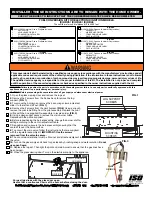
9
6.4
For concealed connection only
Pierce a hole in the seal at the back of the convection box
(see figure 7). The seal must envelop the pipe. If the hole is
larger than the pipe, seal it with tape.
Do not pierce the seal
unless the supply pipe is to pass through it.
6.5
The flue restrictor
This appliance is supplied with a flue restrictor for use
where the flue draught is excessive. The restrictor must
NOT be fitted where a precast flue or a flue liner is used.
For all other installations the restrictor should be fitted.
There may however, be certain exceptional circumstances
where fitting the restrictor causes the fire to fail the spillage
test. In such cases the restrictor will have to be removed.
After removal conduct the spillage check again.
The restrictor is packed loose with the appliance and is
fixed with two screws (See figure 8).
7.
CONVECTION BOX INSTALLATION
7.1
METHOD (1) - FRONT FIXING TO
FIREPLACE SURROUND
M
ake sure that the fireplace front surround area is sound
enough to take the rawlplugs and woodscrews. If necessary,
make sound with a suitable cement.
7.1.1
Place the convection box centrally in the fireplace in
the position in which it is to be permanently installed.
If a concealed connection is being used, insert the
convection box into the fireplace feeding the supply pipe
through the pierced hole in the rear seal.
7.1.2
Mark the fireplace front surround through the four
fixing holes in the side flanges of the convection box (see
figure 9).
7.1.3
Remove the convection box. Drill four holes in the
fireplace front surround at the marked positions using a
no.12 masonry drill.
7.1.4
Insert a rawlplug into each hole.
7.1.5
Place the convection box back in position in the
fireplace.
7.1.6
Fit a woodscrew through each hole in the
convection box flanges and tighten to seal the box to the
fireplace surround.
7.2
METHOD 2 - CABLE RETENTION
AND FLOOR FIXING
Make sure that the areas at the back and towards the
centre of the fireplace floor are sound enough to take the
eyebolts and screws. If these areas have deteriorated due to
prolonged use, they should be made sound with a suitable
cement.
7.2.1
Drill four holes in the rear wall of the fireplace for
the eyebolt plugs. The holes should be drilled within the
range of positions shown in figure 10 using a no.12
masonry drill. The holes should be equidistant each side of
the centre line of the fireplace to ensure that the appliance
finishes centrally in the opening when tension is applied to
the cables.
Fig. 7 Concealed connection seal piercing
Fig. 8 Flue restrictor
Fig. 9 Front fixing
Fig. 10 Eyebolt positions
Содержание BR
Страница 10: ...10...






































